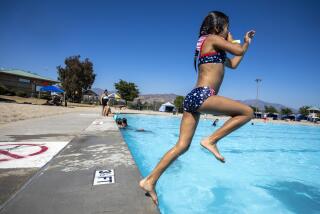Safety Device Could Have Prevented 2 Sisters’ Electrocution, Experts Say
- Share via
As relatives and friends comforted one another after a hair dryer electrocuted two Lynwood girls playing in a bathtub, consumer safety experts said the tragedy could have been prevented with a simple, inexpensive device.
Appliance manufacturers have made hair dryers nearly accident-proof in recent years, largely because of new standards that encourage--but don’t require--equipping them with a device that stops the flow of current if a dryer is submerged in water, safety experts said.
Called ground fault circuit interrupters, the devices are also installed in electrical outlets in bathrooms and kitchens of most new homes. They can be purchased at most hardware stores for about $8.
But authorities say millions of people may be risking accidents because they use dryers manufactured before new safety standards took effect in 1991, or because they live in older homes without the safe outlets.
“Unfortunately, this is how we learn,” said Lynwood Fire Capt. Norm Ortner.
The bathroom where Michelle Palomera, 9, and her sister, Stephenie, 7, were killed was designed with an electrical outlet only a few inches from the bathtub where the girls were found, fire officials said. Neither the home nor the dryer was equipped with the safety device, they said.
The girls were taking a cool bath Wednesday afternoon to escape the soaring temperatures that neared triple digits outside. Investigators said the girls’ parents were not home, and they were being cared for by a 13-year-old cousin. He knocked on the bathroom door every few minutes to check on the girls, and they said they were fine shortly before 4 p.m., investigators said. Fifteen minutes later, he checked again, but no one answered.
When he opened the door, he found the girls motionless, one of them fully submerged. Instinctively, he reached in to pull them out but immediately felt a jolt, authorities said. He tried once more and received another shock.
The boy then apparently managed to pull one of the girls out and dialed 911.
The operator instructed the boy to unplug the hair dryer and dispatched firefighters to the scene. By the time they arrived, the boy had pulled the other girl from the bathtub.
Both girls had turned purplish from exposure to the current, firefighters said. Ortner said he and a sheriff’s deputy performed cardiopulmonary resuscitation on Michelle, while two other firefighters tried to revive Stephenie. Paramedics rushed the younger girl to St. Francis Medical Center and her sister to Martin Luther King Jr./Drew Medical Center. Both were pronounced dead shortly after arrival.
Family members were huddled in the one-story stucco house in the 4200 block of Platt Avenue late Thursday and declined to talk to reporters. Friends said both girls attended Lynwood’s Washington Elementary School.
A fund in the girls’ names is being established at the California United Bank in Lynwood, said Errick R. Lee, executive director of the Lynwood Chamber of Commerce. Donations can be sent to the chamber, 3651 Imperial Highway, P.O. Box 763, Lynwood CA 90262.
Authorities say similar accidents were once common. In the early 1980s, federal Consumer Product Safety Commission officials said, there were an average of 18 fatal electrocutions linked to hair dryers each year, nearly all of them occurring when the appliance fell into a bathtub full of water. Only a label with a picture warning against using dryers in bathtubs was required then.
In 1985, the commission recommended that new hair dryers include written instructions explaining the need to install circuit interrupters in bathrooms. Two years later, the agency toughened its recommendations, saying dryers should be outfitted with devices to prevent electrocutions if the appliance fell into water while switched off.
Commission research, however, later determined that even with such devices, about eight children would be killed in accidents each year. In 1991, the agency recommended that dryers be built to automatically shut off when immersed in water.
Manufacturers are not required to conform to commission recommendations to sell their products. But they must meet those standards to get certification from Underwriters Laboratories, a commission spokeswoman said.
In 1992, the most recent year for which data were available, there were only two hair dryer-related electrocutions, a commission spokeswoman said.
But agency officials say there are still millions of hair dryers in homes today that provide no protection against accidents--either because they were purchased before the tougher standards took effect or were not manufactured in compliance with the standards.


